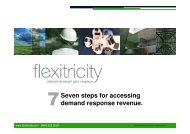EfW & The Hierarchy: - Sustainability Live
EfW & The Hierarchy: - Sustainability Live
EfW & The Hierarchy: - Sustainability Live
- No tags were found...
Create successful ePaper yourself
Turn your PDF publications into a flip-book with our unique Google optimized e-Paper software.
<strong>EfW</strong> & <strong>The</strong> <strong>Hierarchy</strong>:Perceptions, Circularity &Economic RealitiesChris JonasHead of Strategic Development
AgendaIntroducing Viridor<strong>EfW</strong> in a circular economy<strong>EfW</strong> and the waste hierarchyEconomics of <strong>EfW</strong>Investment in <strong>EfW</strong>Case Studies:Runcorn, Cardiff, OxfordUK <strong>EfW</strong> capacityExport of energyConclusions
About ViridorAt Viridor we sift, sort andsegregate waste to transformit into valuable commodities;whether that’s quality materialsthat can be recycled into newproducts or energy for theNational Grid. Part of the FTSE 250 Pennon Group Supporting 100 UK local authorities and over 20,000customers through a network of 327 facilities Responsibly managing 8m tonnes of waste each year Over 2.4m tonnes recycled or recovered each year Generating 136MW of renewable energy each year 3,200 employees with a turnover of c.£761 million Accredited to ISO14001, ISO 9001 & OHSAS18001environmental, quality and health & safety standards
Whenever we canwe put waste backinto action.
<strong>The</strong> Viridor network fortransforming waste 43 Transfer stations 37 Collection Services Depots 25 Materials Recycling Facilities 22 Operational Landfills 15 Composting/organics recycling facilities 4 Anaerobic Digestion Facilities 3 Energy from waste facilities operational 9 Energy from waste facilitiesin development or consented
Viridor: <strong>EfW</strong> Network Lakeside Operational. 410K tpa. 34 MW power + heat soon. (JV with Grundon) Bolton Operational. 100K tpa. 8 MW. Runcorn Under construction. 800K tpa; 70 MW power; 50 MW heat (JV) Ardley Under construction. 300K tpa; 24 MW Cardiff Under construction. 350K tpa; 30MW + 20MW heat Exeter Under construction. 60K tpa; 3MW Peterbourgh Planning approved & EPC contract agreed. 85K tpa; 7MW Glasgow Planning approved & EPC contract agreed. 200K tpa; 15MW Dunbar Planning approved. 300K tpa; 25MW Avonmouth Planning approved. 350K tpa; 30MW Beddington Planning recommended & EPC contract agreed. 300K tpa; 26MW
<strong>EfW</strong> in a Circular EconomyIn an ideal world all wastewould be prevented. Wewould inhabit a genuinelyzero waste society.But in our real world, for abroad range of political, social,economic and practicalreasons we all generatesurplus waste resources.How we deal with this realityis the waste hierarchy – wasteprevention, reuse, recycling,recovery and disposal.
<strong>EfW</strong> in a Circular Economy<strong>The</strong> waste hierarchy isboth a guide tosustainable wastemanagement and a legalrequirement of the EUWaste FrameworkDirective.Enshrined in law through the Waste(England and Wales) Regulations2011 and lays down a priority orderof what constitutes the bestenvironmental option for managingwaste.Whilst it is important that <strong>EfW</strong> doesnot become a barrier to capturingthese elements in future, it isequally important that wherecurrent barriers exist, <strong>EfW</strong> should beutilised to recover low carbonenergy.
<strong>EfW</strong> in a Circular Economy<strong>The</strong> combustion of waste washistorically used primarily asa tool for reducing thevolume of solid wasterequiring disposal. As suchcombustion was traditionallyconsidered on par withlandfill.Why do we view this sodifferently today?
<strong>EfW</strong> in a Circular Economy<strong>The</strong> answer lies in the environmental impact of the carbon containedwithin the waste and the energy produced by the process. <strong>The</strong> Climate Change Act established legally binding targets to reduceUK greenhouse gas emissions by 80%. In 2007 direct greenhouse gas emissions from waste amounted to 4%of total UK emissions – with circa 90% of those emissions being fromlandfill. Whilst landfill produces CO2 and methane, <strong>EfW</strong> produces CO2 alone.With methane being 25x more damaging to the environment, theroute which produces the lower volume of greenhouse gas emissions isplaced higher in the waste hierarchy.
<strong>EfW</strong> in a Circular EconomyIn addition to landfill diversion and moving materials up the wastehierarchy, <strong>EfW</strong> also provides valuable low carbon energy <strong>EfW</strong> can play an important role in domestic energy security. <strong>EfW</strong> can contribute to our renewable energy targets aimed atdecarbonising energy generation. <strong>EfW</strong> has the added advantage that it is non-intermittent and so cancomplement other renewable energy sources such as wind and solar. <strong>EfW</strong> is particularly effective when combined with commercial and /ordistrict heating schemes.
<strong>EfW</strong> and the waste hierarchy<strong>EfW</strong> is – a central component – in our waste hierarchy.Modern <strong>EfW</strong> facilities, working in conjunction with materials recycling andanaerobic digestion technologies, operate today, and every day, across theglobe.<strong>The</strong>y operate across Europe in countries which combine some of thehighest rates of recycling with well-developed energy from wasteinfrastructure (like Denmark and the Netherlands).<strong>The</strong>y operate to stringent environmental standards even in locations likeShetland which SEPA rates as ‘Excellent’ and where the sensitivelydesigned facility feeds a district heating scheme serving 1,000 properties.
Economics of <strong>EfW</strong><strong>EfW</strong>, along with the waste hierarchy, can respond to economic realities.With over 20 plants in the UK and 400 across Europe, <strong>EfW</strong> provides asecure, proven, financially viable and cost effective solution for moving upthe waste hierarchy.DEFRA itself concedes that “the waste hierarchy is not inflexible. Where aclearly better environmental outcome can be shown, it is possible todepart from the waste hierarchy.”<strong>EfW</strong> suffers today from its poor historical image. That image is persistentbut outdated.
Investment in <strong>EfW</strong>£3.8bn investment in UK <strong>EfW</strong> over the last five years.More than 50% of this investment made by a few operators.£6.8bn investment in UK <strong>EfW</strong> required over the next six years.[ENDS Report March 2013].Of that, Viridor will invest over £1bn in UK ‘next generation’energy generation infrastructure.
Case Study: RuncornBuilt in two phases, combined plantwill be one of the largest and mostefficient in Europe producing 70MWof electricity and 51MW of heat.800,000 tonne fuel input EnergyRecovery FacilityPhase I supports Viridor’spartnership with the GreaterManchester Waste DisposalAuthority (GMWDA),.Phase II will support otherauthorities wishing to move wasteinto energy by rail
Case Study: Cardiff30MW of renewable energy andpartnership with E.ON and CardiffCouncil for 20MW of heat output.350,000 tonne fuel input Energyfrom Waste facility with CombinedHeat and Power.Supporting Viridor’s preferredbidder status on Prosiect Gwyrddwith additional capacity.
Case Study: Oxfordshire£200m, 300,000 tonne Energy fromWaste facility.24MW of renewable energy withCHP capacity.Supporting Viridor’s contract withOxfordshire County Council withadditional commercial capacity.
<strong>EfW</strong> capacity - now<strong>The</strong> UK has a predominantly market-led approach to infrastructure whichin DEFRA’s view “should help avoid the development of too much, or toolittle, energy from waste capacity.”<strong>The</strong> proportion of all local authority managed waste in England treated by<strong>EfW</strong> was 19.1% in November 2012.[DEFRA Energy from Waste Report, Feb 2013].A 2010 survey found only 2% of commercial and industrial waste wastreated by <strong>EfW</strong> in England.[DEFRA Energy from Waste Report, Feb 2013].In 2012, 25 facilities were operating in the UK processing MSW and similarwastes using some form of thermal treatment, many of these export someform of energy.
<strong>EfW</strong> capacity - futureViridor’s internal analysis points toover 130 new projects involvingthermal treatment of MSW typewastes to generate energy(excluding AD, biomass, MBT,autoclave).<strong>The</strong> facilities have a nominalcapacity of 25 million input tonnesof fuel.It is likely that a significantnumber of these projects will notbe delivered by 2020.140120100806040200ADDITIONAL EFW FACILITIES BY2020PROPOSED ADDITIONALFACITITIESDEVELOPED ADDITIONALFACILITIES
<strong>EfW</strong> capacity - futureWhen combined with currentplants these will require anominal feedstock of circa 13mtonnes per annum of fuel.Of this Viridor will havedeveloped 9 new plants, on topof existing plants, and will beusing over 2m tonnes of fuel togenerate over 170MW ofrenewable energy, realising CHPpotential.252015105Additional fuel inputcapacity by 2020, mt0PROPOSED ADDITIONAL MWCAPACITYDEVELOPED ADDITIONAL MWCAPACITY
Export of residual wastesDEFRA guidance states that “the UK has a long-standing policy of selfsufficiencyfor waste disposal and the UK plan for shipments of wasteprohibits the export of waste for disposal.”Paradoxically, DEFRA also states that “waste may be exported for recovery,which can have advantages over managing it within the UK.”<strong>The</strong> Environment Agency has permittedover 2m tonnes of waste-derived fuelsto be lost from the UK economyannuallyIn 2012 nearly 1m tonnes of fuel wasexported to northern Europe
Export of residual wastesThis is frankly madness – a Jekyll and Hyde policy framework whichsupports the export of UK PLC resources capable of powering growth inour economy, providing energy security and helping tackle fuel poverty.Consider that each lorry of waste exported could power 5 to 6 UK homesfor a whole year.What’s more, we not only export UK resources, but then we purchaseEuros to send 30 days after we send the lorry load.“<strong>The</strong> Government is keen to support domestic RDF and SRF markets, wherethey can provide better environmental outcomes, to ensure that the UKbenefits from the energy generated from UK waste.” – DEFRA Feb 13This is a short-term position which has to change.
Conclusions<strong>EfW</strong> is a “key enabler” for the circular economy.<strong>EfW</strong> is at the heart – a central component – in our waste hierarchy.<strong>EfW</strong> provides a constant source of valuable low carbon energy, aidingenergy security and the UK’s renewable energy targets.Whilst <strong>EfW</strong> continues to suffer from its poor historical image it’s importantwe challenge that perception.Challenge too we must the perception of <strong>EfW</strong> crowding out recycling andthat of a tidal wave of UK over capacity fast approaching our shore.We must end the madness of a Jekyll and Hyde policy framework whichsupports the export of UK PLC resources then pays for the privilege.<strong>EfW</strong> reflects well the economic realities of our generation and workingtogether we can, we must, change perceptions of this dynamic industry.
Some see waste.We see renewable energy.Head OfficeViridor HousePriory Bridge RoadTauntonSomersetTA1 1APTel: 01823 721 400www.viridor.co.uk






